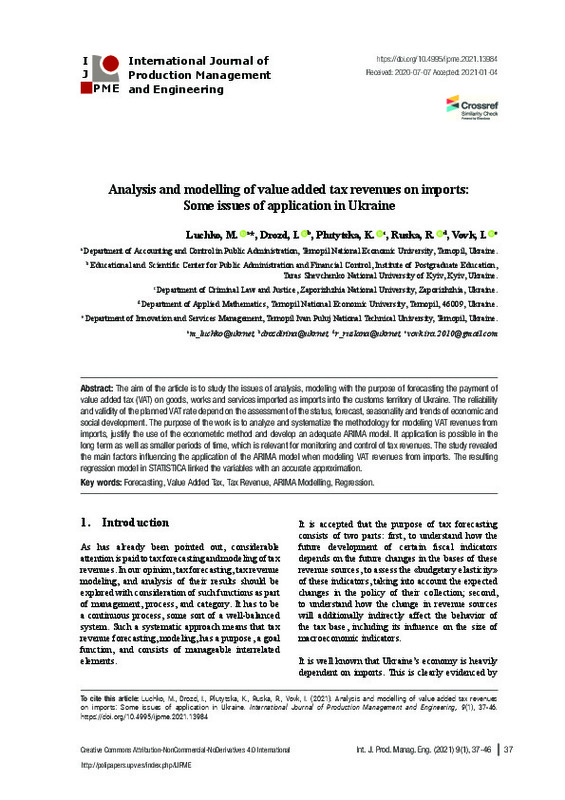Andrejovska, A., Pulikova, V. (2018). Tax revenues in the context of economic determinants. Montenegrin Journal of Economics, 14(1), 133-141. https://doi.org/10.14254/1800-5845/2018.14-1.10
Bilan, Y., Mishchuk, H., Samoliuk, N., Yurchyk, H. (2020). Impact of Income Distribution on Social and Economic Well-Being of the State. Sustainability, 12(1), 429. https://doi.org/10.3390/su12010429
Bogetic, Z., Hassan, F.M. (1993). Determinants of Value-Added Tax Revenue: A Cross-section Analysis (Vol. 1203). World Bank Publications.
[+]
Andrejovska, A., Pulikova, V. (2018). Tax revenues in the context of economic determinants. Montenegrin Journal of Economics, 14(1), 133-141. https://doi.org/10.14254/1800-5845/2018.14-1.10
Bilan, Y., Mishchuk, H., Samoliuk, N., Yurchyk, H. (2020). Impact of Income Distribution on Social and Economic Well-Being of the State. Sustainability, 12(1), 429. https://doi.org/10.3390/su12010429
Bogetic, Z., Hassan, F.M. (1993). Determinants of Value-Added Tax Revenue: A Cross-section Analysis (Vol. 1203). World Bank Publications.
Büyükşahin, Ü.Ç., Ertekin, Ş. (2019). Improving forecasting accuracy of time series data using a new ARIMA-ANN hybrid method and empirical mode decomposition. Neurocomputing, 361, 151-163. https://doi.org/10.1016/j.neucom.2019.05.099
Danilov, O. (1999). Methodological approach to the economic and mathematical modelling of tax policy. Scientific works UFEI, 3(6), 21.
Ebrill, L.P., Keen, M., Bodin, J.P., Summers, V.P. (2001). The modern VAT. International Monetary Fund. https://doi.org/10.5089/9781589060265.071
Ebrill, L., Keen, M., Bodin, J.P., Summers, V. (2002). The allure of the value-added tax. Finance & Development, 39(2), 44-44.
Gamboa, A.M., Sophia, J. (2002). Development of tax forecasting models: Corporate and individual income taxes (No. 2002-06). PIDS Discussion Paper Series.
Giesecke, J., Tran, N.H. (2012). A general framework for measuring VAT compliance rates. Applied Economics, 44(15), 1867-1889. https://doi.org/10.1080/00036846.2011.554382
IMF. (2001). Manual on Fiscal Transparency. Retrieved March 23, 2020 from, https://www.imf.org.
Jenkins, G.P., Kuo, C.Y., Shukla, G. (2000). Tax analysis and revenue forecasting. Cambridge, Massachusetts: Harvard Institute for International Development, Harvard University. Retrieved from: https://cri-world.com/publications/qed_dp_169.pdf.
Leal, T., Pérez, J.J., Tujula, M., Vidal, J.P. (2008). Fiscal forecasting: lessons from the literature and challenges. Fiscal Studies, 29(3), 347- 386. https://doi.org/10.1111/j.1475-5890.2008.00078.x
Legeida, N., Sologoub, D. (2003). Modeling value added tax (VAT) revenues in a transition economy: Case of Ukraine. Institute for Economic Research and Policy Consulting Working Paper, 22, 1-21.
Louzis, D.P. (2019). Steady state modelling and macroeconomic forecasting quality. Journal of Applied Econometrics, 34(2), 285-314. https://doi.org/10.1002/jae.2657
Luchko, M., Lew, G., Ruska, R., Vovk, I. (2019). Modelling the optimal size of investment portfolio in a non-state pension fund. Journal of International Studies, 12(1), 239-252. https://doi.org/10.14254/2071-8330.2019/12-1/16
Lukianenko, I.H. (2004). Systematic Modelling of Ukraine's Budget System Indicators: Principles and Instruments.
Kyiv, Kyiv-Mohyla Academy. MinFin - Ministry of Finance of Ukraine. (2019). Exports and imports of Ukraine. Retrieved from Official Web Site of the Ministry of Finance of Ukraine https://index.minfin.com.ua/ua/economy/gdp/eximp/
Mishchuk, H., Grishnova, O. (2015). Empirical study of the comfort of living and working environment-Ukraine and Europe: Comparative assessment. Journal of International Studies, 8(1), 67-80. https://doi.org/10.14254/2071-8330.2015/8-1/6
Nikolaiev, V. (2006). Forecasting of tax revenues in the transition economy: problems of methodology and organization. Kyiv: MP Lesia.
Rudzkis, R., Maciulaityte, E. (2007). Econometrical Modelling of Profit Tax Revenue. Nonlinear Analysis: Modelling and Control, 12(1), 95-112. https://doi.org/10.15388/NA.2007.12.1.14724
Sabaj, E., Kahveci, M. (2018). Forecasting tax revenues in an emerging economy: The case of Albania (No. 84404). University Library of Munich, Germany.
Shahnazarian, H., Solberger, M., Spånberg, E. (2017). Forecasting and Analysing Corporate Tax Revenues in Sweden Using Bayesian VAR Models. Finnish Economic Papers, 28(1), 50-74. Retrieved from https://www.taloustieteellinenyhdistys.fi/wp-content/uploads/2017/10/ FEP_1_17_4_Spanberg.pdf
Skrypnyk, A.V., Tereshchenko L.A. (2001). Dynamics of tax revenues and their forecast using the ARIMA model. Modelling and Information Systems in Economics, 66, 7-12.
Soto-Ferrari, M., Chams-Anturi, O., Escorcia-Caballero, J. P., Hussain, N., & Khan, M. (2019, September). Evaluation of bottom-up and top-down strategies for aggregated forecasts: state space models and arima applications. In International Conference on Computational Logistics (pp. 413-427). Springer, Cham. https://doi.org/10.1007/978-3-030-31140-7_26
State Tax Service of Ukraine. (2020). Income of taxes and fees. Retrieved from Official Web Site of the State Tax Service of Ukraine: https://tax.gov.ua/diyalnist-/pokazniki-roboti/nadhodjennya-podatkiv-i-zboriv--obovyaz/nadhodjennya-podatkiv-i-zboriv/.
Stock, J.H. (2001). Time Series: Economic Forecasting. International Encyclopaedia of the Social & Behavioural Sciences. 15721-15724. https://doi.org/10.1016/B0-08-043076-7/00526-X
Tiao, G.C. (2001). Time series: ARIMA methods. International Encyclopedia of the Social & Behavioural Sciences, 15704-15709. https://doi.org/10.1016/B0-08-043076-7/00520-9
[-]









